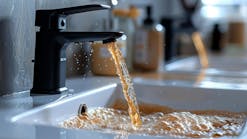About the author: Diane M. Haskett is president of Chlorinators, Inc. You may contact the company for complimentary technical bulletins at 561-288-4854; www.regalchlorinators.com.
Diane M. Haskett
undefined
There is no question that the use of chlorine offers you a highly effective way to purify water and wastewater. The only question is: Which form of chlorine should you use?
Chlorine is supplied as a gas, liquid and a solid. The gas is 100 percent elemental chlorine (Cl2), and is supplied in 150 lb. cylinders (10 inches in diameter and about 55 inches high) and in 2,000 lb. (ton) containers (30 inches in diameter and 82 inches high). The liquid is sodium hypochlorite (NaOCl) commonly used as laundry bleach. And the solid is calcium hypochlorite [Ca(OCl)2], available in granular form or as tablets.
If cost is an issue, chlorine gas is a clear choice because calcium hypochlorite is only 65 percent available chlorine, sodium hypochlorite is 12.5 percent. In a recent survey of prices in eight regions of the United States, sodium hypochlorite cost two to four times as much per available chlorine as the gas and calcium hypochlorite is three to seven times as much.
Feed equipment design and product packaging also favor chlorine gas. Modern gas feeding equipment occupies very little space — basically, the area of the container (less than a square foot for the 150-lb. cylinder, and 17 square feet for the ton containers because the feeding equipment — the chlorinator — mounts directly onto the container.) Let’s compare.
- To equal the chlorine available from one 150-lb. chlorine cylinder, you would need to use
- 180 gallons of sodium hypochlorite or
- 228 pounds of calcium hypochlorite.
- To equal the chlorine available from a one-ton chlorine container, you would need to use
- 2,400 gallons of sodium hypochlorite or
- 3,040 pounds of calcium hypochlorite.
When it comes to actually injecting the chlorine into the water, gas chlorinators utilize a vacuum created by water flowing through a venturi in the "ejector" to draw chlorine directly from the cylinder. Feeding sodium hypochlorite and granular calcium, hypochlorite (slurry) requires a metering pump. Calcium hypochlorite in tablet form requires some form of solid metering device.
If it is consistency and repeatability of feed rate that is critical, gas is again a good choice. The gas is essentially 100 percent pure elemental chlorine (in both liquid and gaseous state inside the cylinder) and remains at that strength until the container is empty no matter how long it is stored. Sodium and calcium hypochlorite degrade as they age, releasing chlorine into the air. This requires constantly increasing the feed rate to maintain dosage level, and doing this typically requires pre- or secondary-mixing. (Changing the feed rate of gas systems, if required, is simply a matter of adjusting a knob on the chlorinator.)
Finally, on the subject of safety, statistics reveal that the form of chlorine most involved in accidents and injuries is the liquid form, sodium hypochlorite. When used as a bleach with other cleansing agents, sodium hypochlorite can burst spontaneously into flame when left too near a heat source, or in contact with an entire group of chemicals. And, sodium hypochlorite can badly irritate skin and damage eyes.
Calcium hypochlorite also can damage skin and eyes. A match dropped into a drum of granular or tablets can set it on fire; contact with oily rags in hot, humid conditions can cause spontaneous combustion; and, if dropped, a sealed container of calcium hypochlorite can explode. Additionally, as they degrade, sodium and calcium hypochlorite vent chlorine into the air.
Chlorine gas, on the other hand, is neither flammable nor explosive. Modern cylinder mounted gas feeding systems draw chlorine from the container with a vacuum, so that a failure of any system component results not in the release of chlorine into the air, but in an automatic and immediate shut-off of the chlorine.


